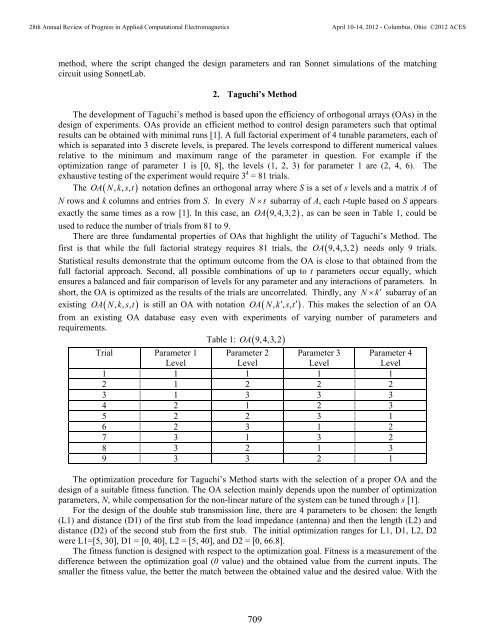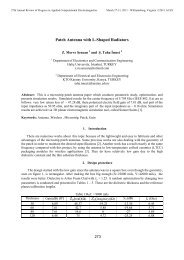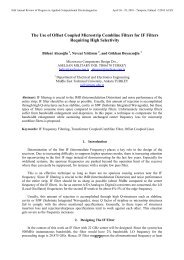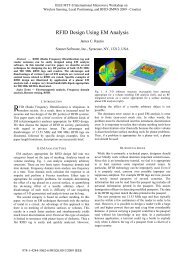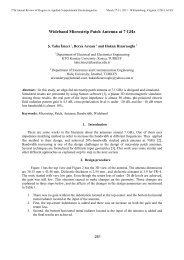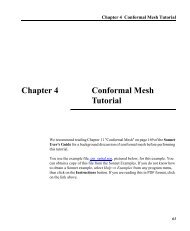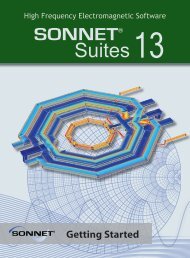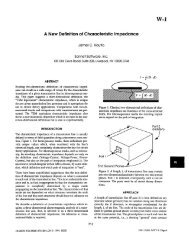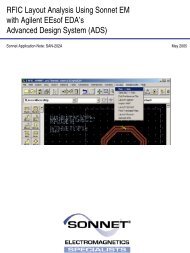Optimization of a Microstrip Matching Circuit at ... - Sonnet Software
Optimization of a Microstrip Matching Circuit at ... - Sonnet Software
Optimization of a Microstrip Matching Circuit at ... - Sonnet Software
You also want an ePaper? Increase the reach of your titles
YUMPU automatically turns print PDFs into web optimized ePapers that Google loves.
28th Annual Review <strong>of</strong> Progress in Applied Comput<strong>at</strong>ional ElectromagneticsApril 10-14, 2012 - Columbus, Ohio ©2012 ACESmethod, where the script changed the design parameters and ran <strong>Sonnet</strong> simul<strong>at</strong>ions <strong>of</strong> the m<strong>at</strong>chingcircuit using <strong>Sonnet</strong>Lab.2. Taguchi’s MethodThe development <strong>of</strong> Taguchi’s method is based upon the efficiency <strong>of</strong> orthogonal arrays (OAs) in thedesign <strong>of</strong> experiments. OAs provide an efficient method to control design parameters such th<strong>at</strong> optimalresults can be obtained with minimal runs [1]. A full factorial experiment <strong>of</strong> 4 tunable parameters, each <strong>of</strong>which is separ<strong>at</strong>ed into 3 discrete levels, is prepared. The levels correspond to different numerical valuesrel<strong>at</strong>ive to the minimum and maximum range <strong>of</strong> the parameter in question. For example if theoptimiz<strong>at</strong>ion range <strong>of</strong> parameter 1 is [0, 8], the levels (1, 2, 3) for parameter 1 are (2, 4, 6). Theexhaustive testing <strong>of</strong> the experiment would require 3 4 = 81 trials.The OA( N, k, s,t ) not<strong>at</strong>ion defines an orthogonal array where S is a set <strong>of</strong> s levels and a m<strong>at</strong>rix A <strong>of</strong>N rows and k columns and entries from S. In every N× t subarray <strong>of</strong> A, each t-tuple based on S appearsexactly the same times as a row [1]. In this case, an OA ( 9,4,3,2), as can be seen in Table 1, could beused to reduce the number <strong>of</strong> trials from 81 to 9.There are three fundamental properties <strong>of</strong> OAs th<strong>at</strong> highlight the utility <strong>of</strong> Taguchi’s Method. Thefirst is th<strong>at</strong> while the full factorial str<strong>at</strong>egy requires 81 trials, the OA ( 9,4,3,2)needs only 9 trials.St<strong>at</strong>istical results demonstr<strong>at</strong>e th<strong>at</strong> the optimum outcome from the OA is close to th<strong>at</strong> obtained from thefull factorial approach. Second, all possible combin<strong>at</strong>ions <strong>of</strong> up to t parameters occur equally, whichensures a balanced and fair comparison <strong>of</strong> levels for any parameter and any interactions <strong>of</strong> parameters. Inshort, the OA is optimized as the results <strong>of</strong> the trials are uncorrel<strong>at</strong>ed. Thirdly, any N× k′ subarray <strong>of</strong> anexisting OA( N, k, s,t ) is still an OA with not<strong>at</strong>ion OA( N, k′ , s,t′ ) . This makes the selection <strong>of</strong> an OAfrom an existing OA d<strong>at</strong>abase easy even with experiments <strong>of</strong> varying number <strong>of</strong> parameters andrequirements.Table 1: OA ( 9,4,3,2)Trial Parameter 1LevelParameter 2LevelParameter 3LevelParameter 4Level1 1 1 1 12 1 2 2 23 1 3 3 34 2 1 2 35 2 2 3 16 2 3 1 27 3 1 3 28 3 2 1 39 3 3 2 1The optimiz<strong>at</strong>ion procedure for Taguchi’s Method starts with the selection <strong>of</strong> a proper OA and thedesign <strong>of</strong> a suitable fitness function. The OA selection mainly depends upon the number <strong>of</strong> optimiz<strong>at</strong>ionparameters, N, while compens<strong>at</strong>ion for the non-linear n<strong>at</strong>ure <strong>of</strong> the system can be tuned through s [1].For the design <strong>of</strong> the double stub transmission line, there are 4 parameters to be chosen: the length(L1) and distance (D1) <strong>of</strong> the first stub from the load impedance (antenna) and then the length (L2) anddistance (D2) <strong>of</strong> the second stub from the first stub. The initial optimiz<strong>at</strong>ion ranges for L1, D1, L2, D2were L1=[5, 30], D1 = [0, 40], L2 = [5, 40], and D2 = [0, 66.8].The fitness function is designed with respect to the optimiz<strong>at</strong>ion goal. Fitness is a measurement <strong>of</strong> thedifference between the optimiz<strong>at</strong>ion goal (0 value) and the obtained value from the current inputs. Thesmaller the fitness value, the better the m<strong>at</strong>ch between the obtained value and the desired value. With the709


